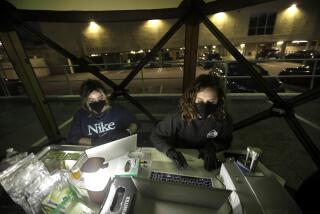In-Home Drug Test Stirring Debate : Personal Health: Firm says its new kit can detect the presence of drugs. Legal experts and rehabilitation specialists are raising concerns.
- Share via
A new home test kit can help parents detect the presence of drugs and start children on the road to recovery, a New York company claims.
SherTest Corp. launched DrugAlert on Monday, advertising the $49.95 test kit on two-minute television commercials in New York. The company plans to expand the campaign to Los Angeles and other major markets.
The test kit is drawing mixed reactions and some concern from legal experts, parents and drug rehabilitation specialists.
Some parents say they would never use the kit, which will be sold through toll-free numbers given through the commercials.
“This reminds me of Big Brother,” said Paul Eventoff of Silver Lake, father of a 13-year-old girl. “I don’t like the idea.”
Others see a role for the test. “If I had reason to suspect (drug use), you bet I would use it,” said Jane Wyner, co-chair of the Orange County Substance Abuse Prevention Network and parent of three teen-agers. “It is a parent’s role to protect their children. And drug abuse is one of our major problems today.”
SherTest bought U.S. manufacturing and marketing rights for the test, developed in Israel, said General Manager Sidney B. Klein. DrugAlert is the company’s only product.
To use DrugAlert, parents wipe a surface where drug residues may lurk--a desk, sink, doorknob or book--with a white paper towel or tissue. Next, they spray the paper or tissue with one of two clear formulas, one, which Klein said is designed to detect cocaine, PCP and crack, the other to detect marijuana and hashish. If the substances are present, he said, they react chemically with the sprays, producing a color change that parents can see.
A positive result does not indicate drug abuse, Klein emphasized. It detects the presence of drugs in the home, not in the child’s system, he said.
Some parents expressed concern that such tests may violate children’s constitutional rights.
That’s a gray area, one legal expert said.
“There is no established case law,” said Barry Litt, an attorney at the Los Angeles public interest law firm Litt & Stormer. “Most likely the court would find that parental use of the test on a child in the home is not a constitutional infringement.”
In the legal sense, the home test is not an invasion of privacy, Litt said. “But in a realistic sense, that doesn’t mean the child’s privacy hasn’t been invaded.”
The danger, as Litt sees it, is out-of-home use. “I see no reason why the next marketing step would not be schools and the workplace. And that has very serious constitutional implications.”
Klein recommends performing the test in the child’s presence. “It’s meant to break the barriers of denial between parent and child,” he said.
Some parents see the kit as counterproductive, potentially damaging parent-child trust.
“I wouldn’t use it,” said John Cherny of Sepulveda, father of two boys, 8 and 14. “I trust my kids and I think what they have been taught at school and at home (about illegal drugs) is enough. They know the bad effects of drugs and I don’t think they would use them.”
“My first question would be, ‘What about false positives?’ ” Wyner said. “The worst thing a parent or a professional could do is accuse . . . on the basis of a false positive.”
But Klein claims that false positives are nearly impossible.
A 260-page paperback book included in the kit, “Not My Kid,” includes advice about when and how to seek professional help. A SherTest customer service number offers help with test instructions and referrals to drug rehabilitation centers.
But experts say awareness can be a parent’s best defense against drug abuse.
“Look for physical and behavioral changes,” said Richard Cone, director of USC’s Joint Educational Project, a drug education program. Two examples: bloodshot eyes and a tendency not to talk to parents after returning home because youths “are not sure they are coherent.”
More to Read
Inside the business of entertainment
The Wide Shot brings you news, analysis and insights on everything from streaming wars to production — and what it all means for the future.
You may occasionally receive promotional content from the Los Angeles Times.










